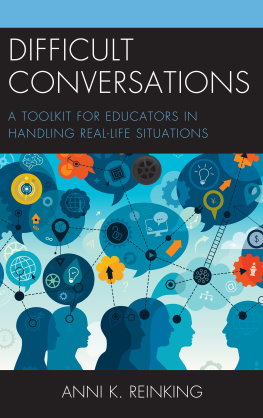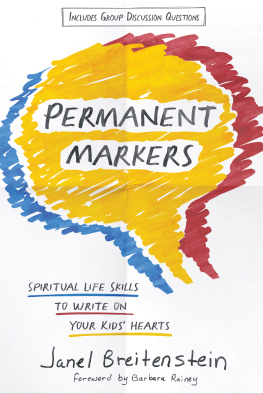Janel Anderson - Head On: How to Approach Difficult Conversations Directly
Here you can read online Janel Anderson - Head On: How to Approach Difficult Conversations Directly full text of the book (entire story) in english for free. Download pdf and epub, get meaning, cover and reviews about this ebook. year: 2018, publisher: Gale House, genre: Romance novel. Description of the work, (preface) as well as reviews are available. Best literature library LitArk.com created for fans of good reading and offers a wide selection of genres:
Romance novel
Science fiction
Adventure
Detective
Science
History
Home and family
Prose
Art
Politics
Computer
Non-fiction
Religion
Business
Children
Humor
Choose a favorite category and find really read worthwhile books. Enjoy immersion in the world of imagination, feel the emotions of the characters or learn something new for yourself, make an fascinating discovery.
- Book:Head On: How to Approach Difficult Conversations Directly
- Author:
- Publisher:Gale House
- Genre:
- Year:2018
- Rating:5 / 5
- Favourites:Add to favourites
- Your mark:
- 100
- 1
- 2
- 3
- 4
- 5
Head On: How to Approach Difficult Conversations Directly: summary, description and annotation
We offer to read an annotation, description, summary or preface (depends on what the author of the book "Head On: How to Approach Difficult Conversations Directly" wrote himself). If you haven't found the necessary information about the book — write in the comments, we will try to find it.
Head On: How to Approach Difficult Conversations Directly — read online for free the complete book (whole text) full work
Below is the text of the book, divided by pages. System saving the place of the last page read, allows you to conveniently read the book "Head On: How to Approach Difficult Conversations Directly" online for free, without having to search again every time where you left off. Put a bookmark, and you can go to the page where you finished reading at any time.
Font size:
Interval:
Bookmark:
Head On
How to Approach Difficult Conversations Directly
Janel Anderson, PhD

Head On: How to Approach Difficult Conversations Directly
Copyright 2018 Janel Anderson
All rights reserved. No part of this book may be reproduced in any form or by any mechanical or electronic means, including information storage and retrieval systems, photocopying or recording, without permission in writing from the author.
Quantity Sales. Special discounts are available on quantity purchases by corporations, associations, educational institutions, or promotional use. For details, please contact the author.
While efforts have been made to verify information contained in this book, neither the author nor the publisher assumes any responsibility for errors, inaccuracies or omissions.
The reader of this publication assumes responsibility for the use of the information. The author and publisher assume no responsibility or liability whatsoever on the behalf of the reader of this publication.
For worldwide distribution. Printed in the U.S.A. Library of Congress Cataloging-in-Publication Data Anderson, Janel K.
Head on: How to approach difficult conversations directly ISBN-13: 978-0-9995809-2-9
Business Communication

For Andrew, Jocelyn, and Blake
who have taught me more about myself and life than they could ever know.
Introduction
H eres a secret, the product of my research, observations, and experience: difficult conversations are made, not born. Even the least acrimonious discussion can become difficult when one person makes another defensive.
When that happens, conversation shuts down. Someone on the defense cant listen or reason well. Its not his fault; its a physiological fact. Heres the scientific explanation: when someone is under attack, the body diverts blood and oxygen away from the neocortex. Thats the part of the brain that performs logical reasoning, and it all but shuts down. Where do these precious resources go instead? The arms and legs. To help that person either throw punches or run. You know: fight or flight.
When you start a conversation by making the other person defensive, its hard to reach agreement. And its darn near impossible to actually come up with a creative or innovative solution.
But theres hope. Ive developed a process for starting and staying with a conversation that has the potential to be difficult-in a way that doesnt make your partner want to put up their dukes or flee the room. Ive been training people in this process for years.
They always ask if theres a book to take home, to consult, to continue helping them through these challenging and undeniable conversations.
And now there is.
WHATS THE SECRET?
Fear and anxiety significantly influence our interpersonal communication at work, whether we want them to or not. Difficult conversations are fraught with these emotions, which in turn, prohibit us from being fully aware and present in those conversations. In those difficult situations, if fear and anxiety run the show, we lose the ability to regulate our thoughts and emotions. Instead, we react. And we react defensively. Most often, these very conversations are the ones in which we most need to be fully aware and present.
What if there were another way? What if you had a method for holding a conversation in a manner that kept defensiveness at bay? Imagine a conversation on a difficult topic with a co-worker or a family member in which neither party got defensive. A conversation in which neither party was provoked to defend her position or protect his self-concept. This book offers just such a method.
The result? Both partners can bring their best listening and critical thinking skills to the table. No one gets upset. Each person begins to understand the other persons position and perspective, even if they dont necessarily agree with them. They also start to see who else is affected by the situation. And finally, they reach agreement, or at least understanding.
This book provides exactly such a process, a process you can begin using in your very next conversation on a difficult topic.
THE SKILLS YOU WILL LEARN
The book is divided into three sections. In the first section, you will come to understand why we get defensive in the first place. This section, Communication and the Brain, takes a close look at what is happening in the brain when we feel threatened and how we are biologically wired to defend ourselves when we encounter threat. Chapter 1 examines what happens in our brains when we face threatening situations and how that directly influences our ability to communicate clearly and effectively with others. Chapter 2 explores stress and the degree to which it supports or inhibits our ability to discuss difficult topics. In Chapter 3 youll come to know some of the major regions of the brain and how each of them plays a role leading up to and during difficult conversations.
The second section of the book specifically describes a step-by-step method for holding conversations on difficult topics, both when you initiate them and when they find you. This section, Difficult Conversations, Step by Step , provides a recipe of discrete, proven steps to follow when conducting the conversation. Chapter 4 goes over the first step in the process: preparing for the conversation, but not in the ways you might typically prepare. Instead, this chapter offers guidance on how to ready yourself emotionally for the conversation even when someone else starts it. Chapter 5 covers the critical first steps in how you begin the conversation and offers a process for opening the conversation in a manner that is specifically designed to lower the other persons defenses.
Chapter 6 offers a technique for staying present in the conversation and dynamically responding to the other person so they feel heard and acknowledged. Chapter 7 prompts you to get curious and stay curious throughout the conversation. It encourages you to think more expansively about who is affected by the situation. And Chapter 8 helps you reach agreement even when agreement is hard to come by. It also addresses the inevitability that sometimes we arent able to reach agreement, and explains how to close those conversations with the relationship intact.
The third section, Difficult Conversations in Context, applies the content from the first two sections to specific situations in work life. Chapter 9 addresses holding difficult conversations with your teams and how to approach problematic issues as they arise in meetings. In Chapter 10, you will learn how to handle awkward and difficult situations as they occur with colleagues in common areas such by the copier or in the cafeteria. Chapter 11 provides guidance on facilitating your annual performance review as well as incorporating feedback throughout the year for continuous improvement. Chapter 12 examines difficult conversations with senior leaders.
Finally, Chapter 13 concludes with a discussion on how to drive lasting cultural change, so that confronting difficult situations in organizations head on becomes commonplace.
A WORD ABOUT EXAMPLES
I provide a lot of stories throughout this book to illustrate the points Im making and to demonstrate the concepts and techniques in action. In the years Ive been doing this work, Ive trained, given speeches, coached, and facilitated meetings for literally tens of thousands of people. Ive heard stories that may sound very similar to your experiences. Other stories may surprise you, amaze you, or be drastically different from your experience. I use some of those stories in this book.
Next pageFont size:
Interval:
Bookmark:
Similar books «Head On: How to Approach Difficult Conversations Directly»
Look at similar books to Head On: How to Approach Difficult Conversations Directly. We have selected literature similar in name and meaning in the hope of providing readers with more options to find new, interesting, not yet read works.
Discussion, reviews of the book Head On: How to Approach Difficult Conversations Directly and just readers' own opinions. Leave your comments, write what you think about the work, its meaning or the main characters. Specify what exactly you liked and what you didn't like, and why you think so.











